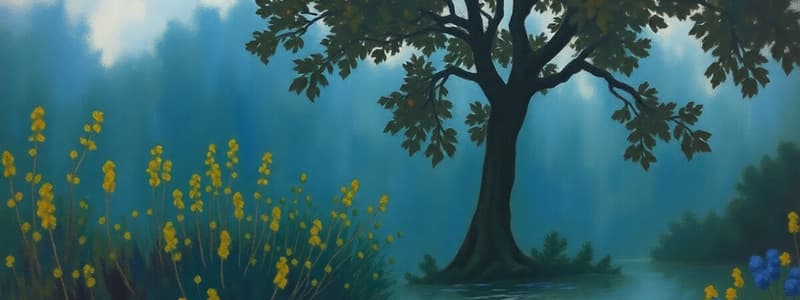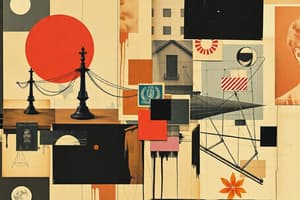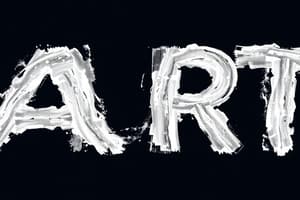Podcast
Questions and Answers
What role does line play in artwork?
What role does line play in artwork?
- It creates depth and perspective.
- It provides structure and guides the viewer’s eye. (correct)
- It represents form and volume in a composition.
- It enhances tactile quality and visual interest.
Which element of art is primarily responsible for conveying mood and emotions?
Which element of art is primarily responsible for conveying mood and emotions?
- Shape
- Space
- Value
- Color (correct)
How does texture contribute to a work of art?
How does texture contribute to a work of art?
- By providing three-dimensional depth.
- By organizing the composition and creating patterns.
- By enhancing the tactile quality and making it visually interesting. (correct)
- By contrasting light and dark areas.
What is the main purpose of elements of art in a composition?
What is the main purpose of elements of art in a composition?
What does the element of space do in artwork?
What does the element of space do in artwork?
How does transcreation impact the adaptation of artistic works?
How does transcreation impact the adaptation of artistic works?
Which element contrasts light and dark areas in artwork?
Which element contrasts light and dark areas in artwork?
What is an example of transcreation in art?
What is an example of transcreation in art?
What does form add to a piece of art?
What does form add to a piece of art?
What is an important characteristic of the element of shape in art?
What is an important characteristic of the element of shape in art?
What principle of design is demonstrated by the arrangement of figures, colors, and overall composition in 'The Birth of Venus'?
What principle of design is demonstrated by the arrangement of figures, colors, and overall composition in 'The Birth of Venus'?
Which type of balance is illustrated in 'The Starry Night'?
Which type of balance is illustrated in 'The Starry Night'?
In 'The Persistence of Memory', what element primarily draws attention to the melting clocks?
In 'The Persistence of Memory', what element primarily draws attention to the melting clocks?
What design principle is illustrated by contrasting colors, shapes, and sizes in 'Composition VIII'?
What design principle is illustrated by contrasting colors, shapes, and sizes in 'Composition VIII'?
Which concept does 'Vitruvian Man' by Leonardo da Vinci represent?
Which concept does 'Vitruvian Man' by Leonardo da Vinci represent?
What principle is depicted in 'The Great Wave Off Kanagawa' through its waves?
What principle is depicted in 'The Great Wave Off Kanagawa' through its waves?
Which artwork exemplifies the use of variety through different colors and arrangements of a repeated motif?
Which artwork exemplifies the use of variety through different colors and arrangements of a repeated motif?
What role does contrast play in visual art as evidenced in various artworks?
What role does contrast play in visual art as evidenced in various artworks?
Which design principle focuses on the distribution of visual weight in a composition?
Which design principle focuses on the distribution of visual weight in a composition?
What element does 'The Persistence of Memory' utilize to create an engaging focal point?
What element does 'The Persistence of Memory' utilize to create an engaging focal point?
What does the Rule of Thirds primarily help with in composition?
What does the Rule of Thirds primarily help with in composition?
How is the image divided when applying the Rule of Thirds?
How is the image divided when applying the Rule of Thirds?
Which of the following statements about focal points in the Rule of Thirds is correct?
Which of the following statements about focal points in the Rule of Thirds is correct?
In Samuel Peploe's Still Life with Coffee Pot, where does the horizontal line of the table edge run?
In Samuel Peploe's Still Life with Coffee Pot, where does the horizontal line of the table edge run?
What does the overlapping areas of the lines in the Rule of Thirds represent?
What does the overlapping areas of the lines in the Rule of Thirds represent?
What is the main focus of transcreation?
What is the main focus of transcreation?
What is a common mistake when applying the Rule of Thirds?
What is a common mistake when applying the Rule of Thirds?
How does distortion influence transcreation?
How does distortion influence transcreation?
In the application of the Rule of Thirds, what is generally preferred for stronger compositions?
In the application of the Rule of Thirds, what is generally preferred for stronger compositions?
What type of transformation is exemplified by Salvador Dalí's work?
What type of transformation is exemplified by Salvador Dalí's work?
Where does the reflected light on the teapot in Peploe's painting sit in relation to the vertical lines of the Rule of Thirds?
Where does the reflected light on the teapot in Peploe's painting sit in relation to the vertical lines of the Rule of Thirds?
What does appropriation in art refer to?
What does appropriation in art refer to?
Which of the following is not a principle of the Rule of Thirds?
Which of the following is not a principle of the Rule of Thirds?
What does the Rule of Thirds suggest about the placement of elements in a composition?
What does the Rule of Thirds suggest about the placement of elements in a composition?
Which of the following best describes the principle of unity in art?
Which of the following best describes the principle of unity in art?
In Van Gogh's reinterpretation of Hiroshige's work, what technique does he use to create a unique style?
In Van Gogh's reinterpretation of Hiroshige's work, what technique does he use to create a unique style?
What key feature does transcreation share with the original artwork?
What key feature does transcreation share with the original artwork?
Which of the following artists is known for their appropriation of Keisai Eisen's work?
Which of the following artists is known for their appropriation of Keisai Eisen's work?
What does transformation in transcreation typically involve?
What does transformation in transcreation typically involve?
Which principle of art involves balancing diverse elements into a cohesive artwork?
Which principle of art involves balancing diverse elements into a cohesive artwork?
Flashcards are hidden until you start studying
Study Notes
Elements of Art
- Line: Provides structure, guides the viewer's eye, and conveys emotion.
- Shape: Creates basic forms, organizes composition, and creates patterns.
- Color: Evokes mood, expresses emotions, and creates visual interest.
- Space: Determines object relationships, creates depth, and provides a sense of confinement or openness.
- Texture: Enhances artwork's tactile quality, making it visually and physically interesting.
- Value: Contrasts light and dark areas, creates depth, emphasizes shapes, and gives objects solidity.
- Form: Adds depth and realism by representing three-dimensional objects.
Transcreation in Arts
- Involves reinterpreting or adapting creative works to fit new cultural contexts while preserving the essence and purpose.
- Requires creative adaptation and cultural sensitivity to maintain the original artistic vision.
Examples of Transcreation
- Vincent Van Gogh’s “The Courtesan (after Eisen)” was inspired by Keisai Eisen, demonstrating Van Gogh’s fascination with Japanese art.
- Van Gogh’s “Bridge in the Rain (after Hiroshige)” is directly inspired by Utagawa Hiroshige.
- Auguste Rodin’s “The Thinker” has influenced modern sculptures, with artists adapting its expressive forms and themes to address contemporary issues.
Distortion, Transformation, and Appropriation in Transcreation
- Distortion: Changing the original's characteristics like shape, color, or form. Van Gogh's "Bridge in the Rain" reinterprets Hiroshige's woodblock print.
- Transformation: Changing the medium or context of a work. Dalí's "Persistence of Memory" could be adapted into a 3D digital model.
- Appropriation: Using elements from an existing work to create something new. Van Gogh's "The Courtesan" reinterprets Keisai Eisen's work.
Principles of Art
- Unity: All elements in a composition harmoniously work together to create a cohesive whole.
- Balance: Distribution of visual weight, can be symmetrical, asymmetrical, or radial.
- Emphasis: The focal point that stands out and attracts the viewer's attention.
- Contrast: Noticeable difference between elements, creating visual interest.
- Proportion: Size relationships between elements in a composition, maintaining harmony and scale.
- Pattern: Arrangement of alternated or repeated elements, such as shapes, lines, or colors.
- Variety: Use of several design elements that hold the viewer’s attention.
The Rule of Thirds
- Divides an image into thirds horizontally and vertically.
- Focal points are the overlapping areas of the red circles in the diagram.
- Use focal points to draw the viewer's attention to specific elements.
- Samuel Peploe’s "Still Life with Coffee Pot" uses the Rule of Thirds.
Studying That Suits You
Use AI to generate personalized quizzes and flashcards to suit your learning preferences.



